Are your preschoolers getting restless as the temperatures rise? Running out of ideas that keep them both entertained and learning? Wondering how to make the most of sunny days, beaches, and outdoor fun without turning chaos into stress?
Summer activities for preschoolers can be fun, educational, and refreshing, with the right mix of structure and play. From outdoor adventures to literacy-rich games and STEM experiments, the best summer routines combine joy with growth. These activities support brain development, boost confidence through hands-on learning, and help children stay socially engaged in meaningful ways.
Let’s dive into some creative and cool summer ideas to make every day feel like play, with purpose.

Summer Themes for Preschoolers
Summer is the perfect time to introduce fresh learning ideas through summer activities for preschoolers. Thematic play during this season helps children explore the world around them while developing foundational skills. Thoughtfully chosen summer themes also make lesson planning easier for teachers and help parents extend learning at home through playful, purposeful experiences.
Alphabet Theme: Learning Letters Through Summer Fun
One of the most popular summer activities for preschoolers is exploring letters in fun, everyday settings. With an alphabet theme, children can connect letters to beach trips, park signs, or even popsicle wrappers.
Every week, choose a “Letter of the Week” tied to a summer concept, like “B” for Beach, “S” for Sunshine, or “W” for Watermelon. These summer-themed connections help kids engage more deeply with phonics and vocabulary. Outdoor games like alphabet hopscotch or chalk tracing bring literacy to life in a sensory-rich way.

Color Theme: Exploring the Summer Spectrum
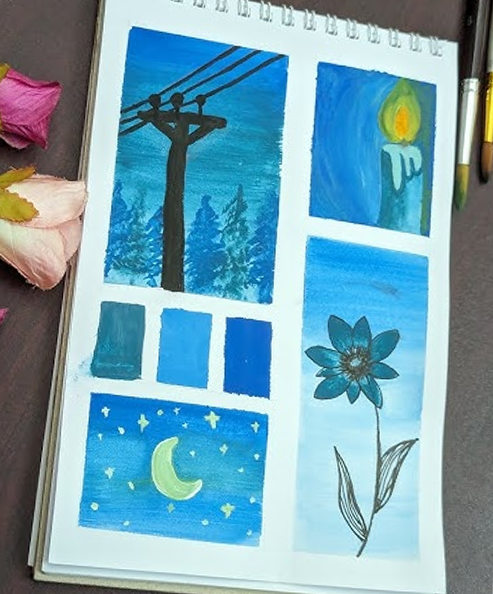
From ice pops to beach towels, summer is bursting with color, making it a perfect season for a color theme in your summer activities for preschoolers.
You can create color-themed weeks where everything revolves around one shade. “Blue Week” might include blueberry snacks, painting with watercolors, and finding blue objects on a nature walk. These activities help children develop color recognition, visual processing, and vocabulary.
Integrating colors into your summer activities for preschoolers makes learning vibrant, engaging, and developmentally enriching.
Nature Theme: Discovering the Outdoors
One of the most natural and effective summer activities for preschoolers is connecting with the outdoors. A nature theme builds curiosity and environmental awareness through direct interaction with the world around them.
Preschoolers can go on bug hunts, create leaf rubbings, or make nature collages from items collected during walks. Journaling what they find in a “summer nature notebook” adds early literacy to the adventure.
By including nature in your summer activities for preschoolers, you’re encouraging scientific thinking, observation skills, and mindfulness, all in the beauty of the great outdoors.

Music and Movement Theme: Dancing Through the Summer

When energy is high and the sun is shining, music and movement become must-have components of your summer activities for preschoolers.
This theme can include musical parades, outdoor dance parties, or creating DIY instruments like tambourines from paper plates. Rhythm sticks and shakers help children explore sound, beat, and sequence, all vital pre-math and pre-literacy skills.
Including rhythm and dance in your summer activities for preschoolers turns every day into a celebration of sound, movement, and developmental growth.

Summer Outdoor Activities for Preschoolers
Summer is the perfect season for children to enjoy the outdoors, and these fun summer activities for preschoolers make every sunny day a chance to learn and grow. From nature walks and water play to gardening and backyard games, these easy outdoor summer activities spark curiosity while strengthening physical skills and social connections.
1. Water Relay Race
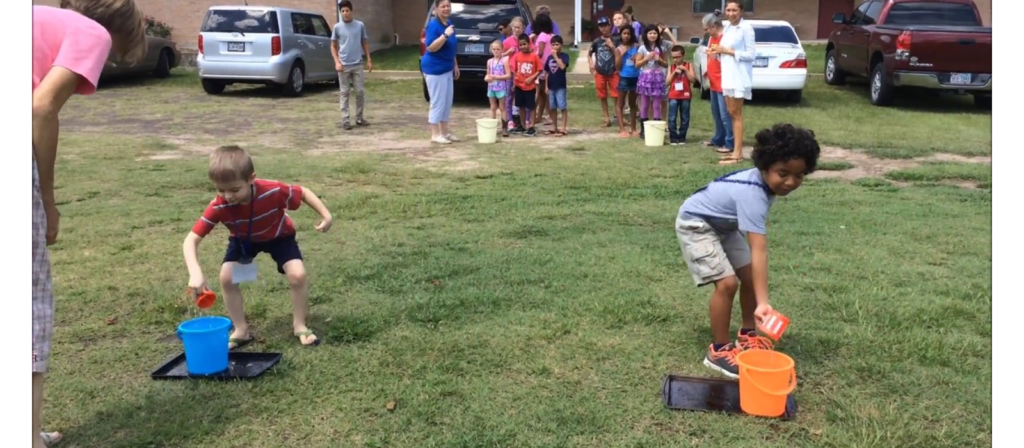
Activity Introduction:
This is one of the most classic and exciting summer activities for preschoolers. Water relay races combine teamwork, movement, and refreshing water play—perfect for hot days and active bodies.
How to Do It:
- Divide children into small teams.
- Place a whole bucket of water at the starting line and an empty bucket at a distance (around 10 feet).
- Each child takes a plastic cup, fills it with water, and runs to dump it into the empty bucket.
- Continue until the target bucket is full.
This activity strengthens coordination, encourages cooperation, and helps children understand simple measurements and cause-and-effect.
2. Sidewalk Chalk Obstacle Course
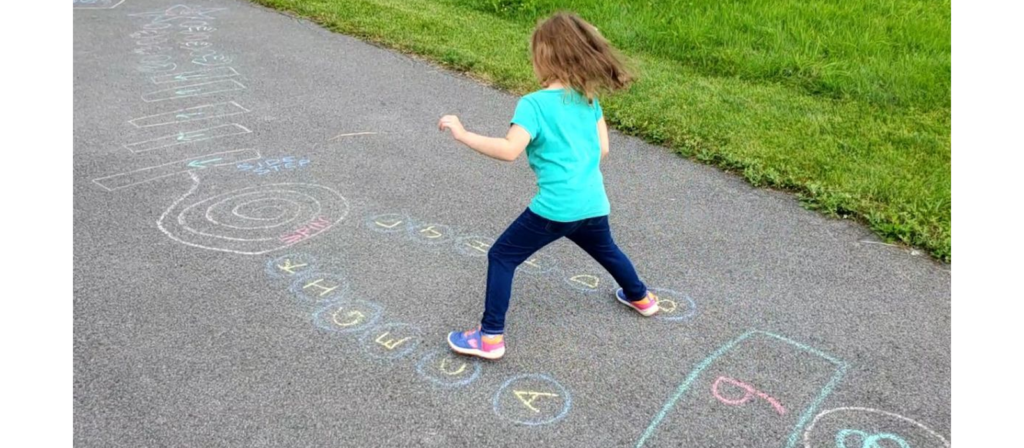
Activity Introduction:
This colorful, low-cost idea ranks high among summer activities for preschoolers because it mixes creativity with movement. The obstacle course can be redesigned daily for new challenges.
How to Do It:
- Use sidewalk chalk to draw a fun course with actions like “Jump,” “Spin,” “Tiptoe,” or “Stomp.”
- Add shapes, arrows, and footprints to guide the children.
- Let kids follow the path and perform each task.
- For advanced learners, invite them to design their courses.
This boosts gross motor skills, spatial awareness, and early literacy (if you write out words).
3. Bug Hunt Safari
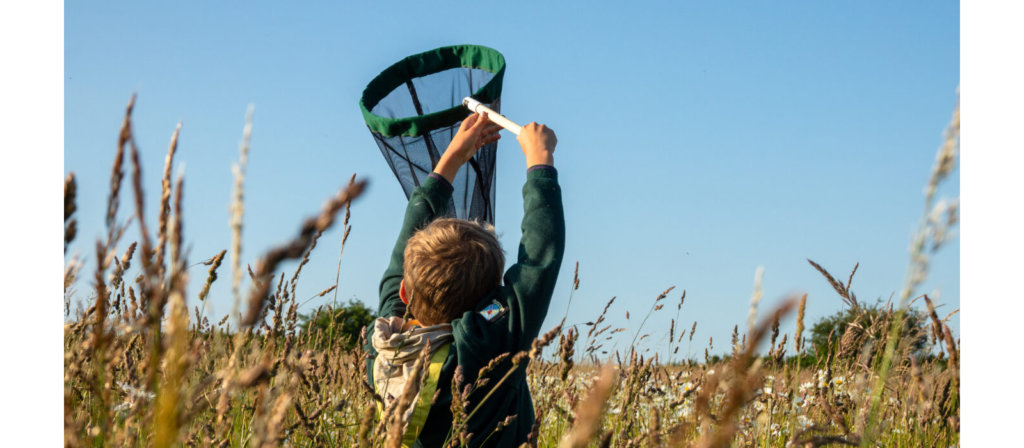
Activity Introduction:
Outdoor exploration is a key feature of summer activities for preschoolers, and bug hunts are a fantastic way to connect science with adventure.
How to Do It:
- Provide magnifying glasses, bug containers, and picture charts of common insects.
- Walk with children through grassy areas, gardens, or parks.
- Please encourage them to gently collect bugs like ants, ladybugs, or beetles and observe them before safely releasing them.
- Invite kids to draw what they see or count insect legs and wings.
This builds observation, counting, early classification, and a love of nature.
4. Sponge Toss Game
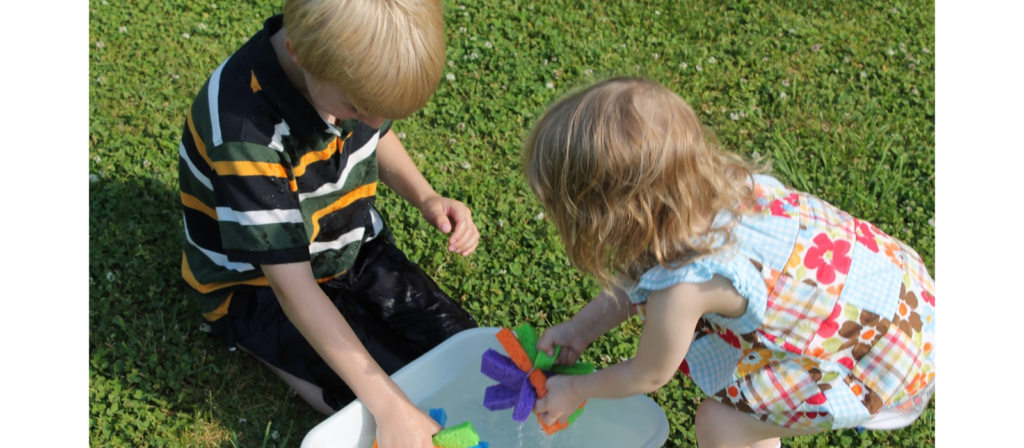
Activity Introduction:
This cooling water game is one of the simplest yet most thrilling summer activities for preschoolers. It encourages hand-eye coordination and math awareness through playful target practice.
How to Do It:
- Fill several buckets with water and soak sponges.
- Set up chalk or taped targets with numbers or colors on a wall or floor.
- Have children toss the soaked sponge to hit a target.
- Score points or match by color/number.
It’s excellent for motor control, color and number recognition, and cooperative play.
5. Picnic Storytime
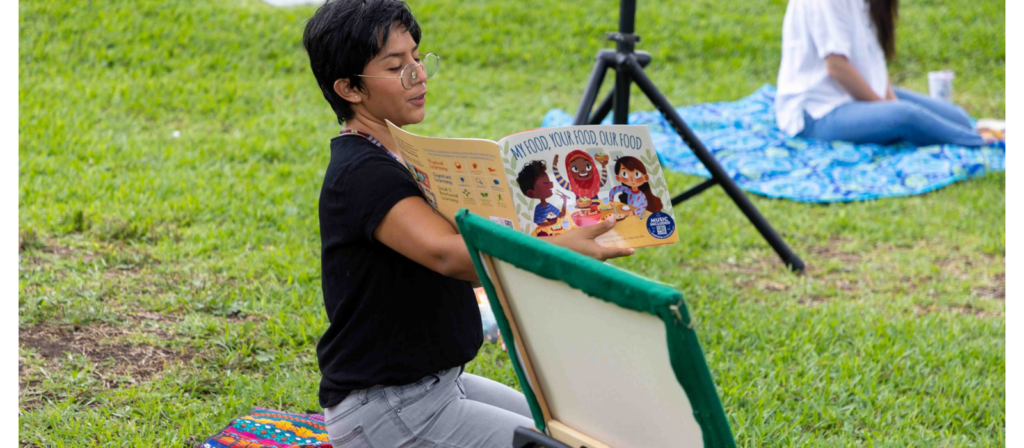
Activity Introduction:
Sometimes, the best summer activities for preschoolers are calm moments in nature. An outdoor picnic combined with storytelling helps children relax, focus, and develop language skills.
How to Do It:
- Pick a shady outdoor spot.
- Have each child bring a small blanket and a snack.
- Choose 1–2 engaging summer-themed books (like “A House for Hermit Crab” or “Summer Days and Nights”).
- Read aloud and then prompt group discussion or encourage children to draw their favorite part.
It’s a gentle way to integrate literacy into summer routines while connecting socially and emotionally.
These summer activities for preschoolers can be adapted to suit different group sizes, energy levels, or lesson themes. Most importantly, they allow children to move, think, explore, and grow—exactly what summer should be about.
Summer Math Activities
Math doesn’t need to be taught with worksheets; it can come to life through play, movement, and hands-on learning. The best summer activities for preschoolers turn everyday moments into math adventures. Below are five math-focused summer activities that help preschoolers build number sense, pattern recognition, spatial awareness, and early logic while having fun under the sun.
6. Ice Cream Cone Counting

Activity Introduction:
Ice cream and summer go hand-in-hand, making this a sweet and effective way to integrate counting into your summer activities for preschoolers.
How to Do It:
- Cut out paper cones and scoops in different colors.
- Write a number (1–10) on each cone.
- Children match the correct number of scoops to each cone.
- You can also use pom-poms or foam balls as “ice cream” for a more tactile version.
This helps with number recognition, counting, and fine motor control.
7. Water Balloon Number Splash

Activity Introduction:
This exciting outdoor game turns water play into a math challenge, making it one of the most engaging summer activities for preschoolers.
How to Do It:
- Write numbers on the ground with chalk or on laminated cards.
- Fill water balloons and mark each with a math problem (like 2+1, 4–2).
- Children solve the problem and throw the balloon at the correct number target.
It reinforces basic operations, number matching, and builds hand-eye coordination.
8. Nature Object Sorting & Graphi
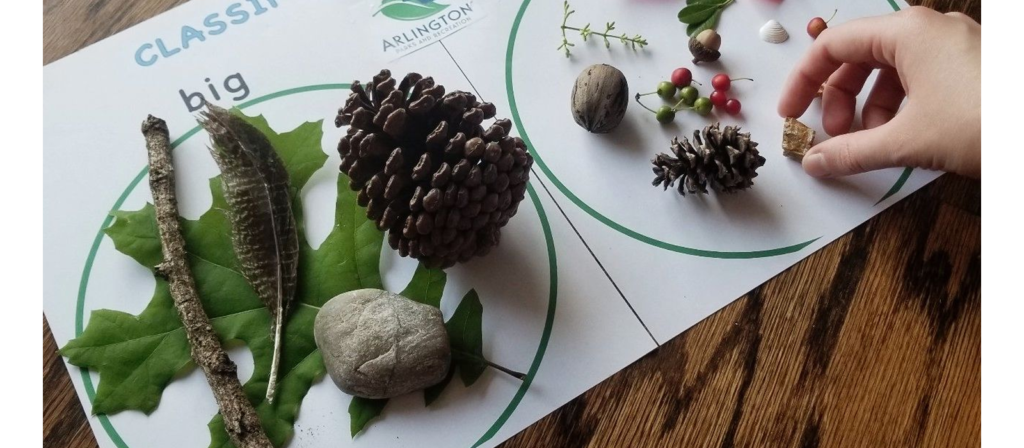
Activity Introduction:
Sorting and graphing are foundational math skills. This nature-inspired version makes it one of the most creative summer activities for preschoolers.
How to Do It:
- Take children on a nature walk and ask them to collect leaves, flowers, rocks, or sticks.
- Once back, have them sort the objects by type, size, or color.
- Use a simple chart or graph template to count how many items they found.
This supports categorization, data collection, and visual math understanding.
9. Pool Noodle Number Jump

Activity Introduction:
Jumping and learning? Yes, please! This gross motor math game perfectly combines movement with counting in your summer activities for preschoolers.
How to Do It:
- Cut pool noodles into pieces and write numbers on each.
- Spread them out in a safe play area.
- Call out numbers or simple addition tasks (“Jump to 5!” or “3 + 2!”) and have children jump to the correct noodle.
- For younger children, focus on number recognition.
This promotes active learning, number identification, and physical confidence.
10. Beach Ball Math Toss
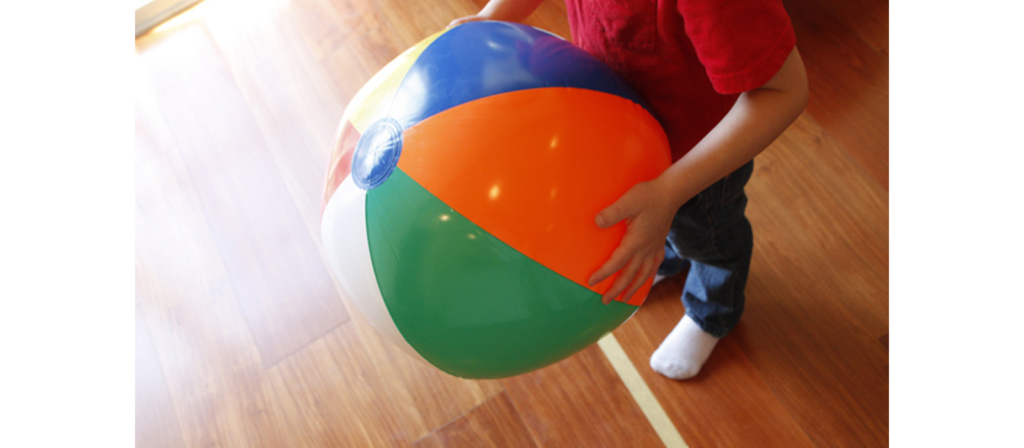
Activity Introduction:
In this versatile, social game, a beach ball becomes a rolling math machine—a standout among group-based summer activities for preschoolers.
How to Do It:
- Use a permanent marker to write numbers or simple equations over a beach ball.
- Sit in a circle and toss the ball around.
- When a child catches it, they name the number or solve the equation closest to their right thumb.
This activity builds quick thinking, number fluency, and collaborative play.
These summer activities for preschoolers help integrate math learning into daily play in a fun, natural way. Whether at school, home, or on vacation, these games make numeracy joyful and memorable.
Summer STEM Activities for Preschoolers
Summer is an ideal time to introduce young learners to the wonders of science, technology, engineering, and math through playful, hands-on exploration. These STEM summer activities for preschoolers transform curiosity into discovery as children build simple structures, experiment with water and gravity, or explore nature-based science projects.
11. Build a Water Wall

Activity Introduction:
A water wall is one of the most stimulating and creative summer activities for preschoolers. It introduces early engineering concepts and cause-and-effect in a fun, wet way.
How to Do It:
- Use a vertical surface like a chain-link fence or wooden board.
- Use zip ties or string to attach recycled materials (plastic bottles, funnels, tubes, sponges).
- Let kids pour water at the top and watch it travel through their custom-built system.
- Allow children to redesign parts for better flow.
This encourages problem-solving, fine motor skills, and engineering design thinking.
12. DIY Baking Soda & Vinegar Volcano

Activity Introduction:
Nothing excites preschoolers like watching a mini volcano erupt! This classic experiment turns into one of the most memorable summer activities for preschoolers when done outside.
How to Do It:
- Mold a volcano shape using playdough, dirt, or a cup inside a mound of sand.
- Fill the “crater” with baking soda.
- Add a few drops of dish soap and food coloring.
- Pour vinegar in and watch the fizz!
This experiment teaches chemical reactions, prediction, and sequencing.
13. Build a Boat That Floats
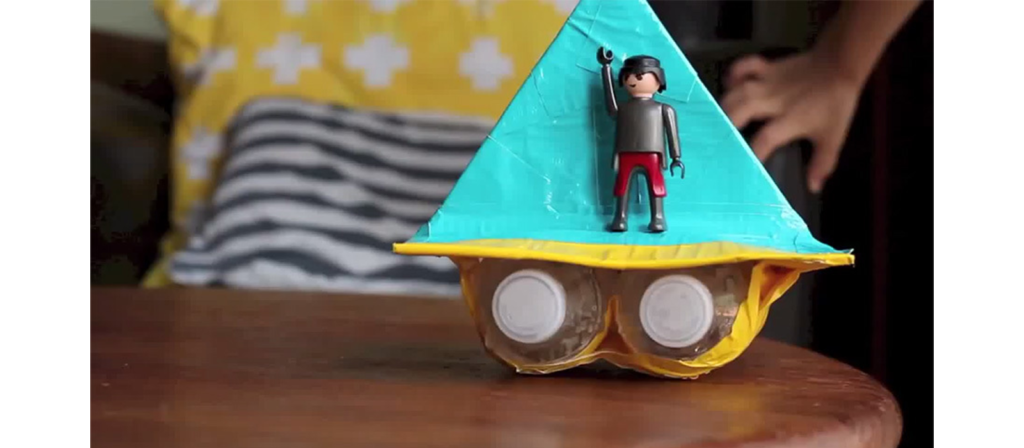
Activity Introduction:
Letting preschoolers design and test boats taps into real-world engineering—and ranks high among water-based summer activities for preschoolers.
How to Do It:
- Provide foam pieces, popsicle sticks, foil, corks, and tape.
- Challenge children to create a small boat that floats in a kiddie pool or basin.
- Test the boats and talk about why some sink or float better.
- Encourage modifications and retesting.
This activity strengthens creativity, hypothesis testing, and spatial thinking.
14. Shadow Science
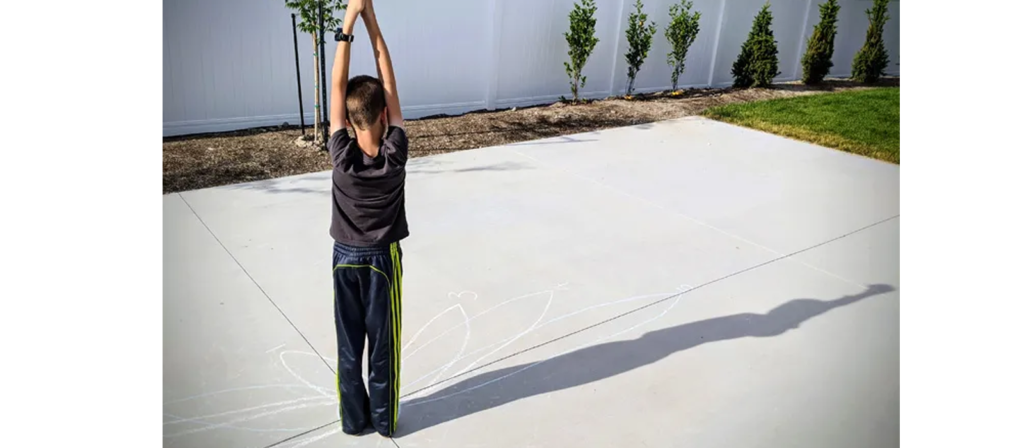
Activity Introduction:
On a sunny summer day, shadows are the perfect way to introduce scientific observation and recording—an easy win for summer activities for preschoolers.
How to Do It:
- Go outside during mid-morning.
- Have children trace their shadows on the pavement with chalk.
- Return later in the day and trace again in a different color.
- Discuss how and why shadows move.
This introduces time, light science, and measurement in a visible, tangible way.
15. Build with Ice Blocks

Activity Introduction:
This sensory-rich activity combines science, building, and cooling off—ideal for hot-weather summer activities for preschoolers.
How to Do It:
- To create blocks, freeze water in various containers (muffin trays, plastic cups, large tubs).
- Provide salt, droppers, food coloring, and small construction toys.
- Let kids build with the ice, watch it melt, and test stability.
- Try sprinkling salt and observing how it changes the texture.
Children explore melting, texture, temperature, and construction stability.
With these summer activities for preschoolers, STEM becomes exciting, messy, and meaningful. Children don’t just follow instructions—they test, question, and invent, which is precisely how future thinkers are made.
Summer Art Activities for Preschoolers
Art and sensory play are essential parts of childhood, and summer is the perfect season to take these experiences outdoors. Messy, colorful, and sensory-rich summer activities for preschoolers help develop creativity, fine motor skills, and emotional expression. These five art and sensory projects are easy to set up, encourage exploration, and engage kids fully.
16. Ice Painting

Activity Introduction:
This cool twist on painting is both artistic and sensory. It’s a refreshing and colorful choice among summer activities for preschoolers, especially on hot days.
How to Do It:
- Fill ice cube trays with water and add a few drops of food coloring to each section.
- Stick a popsicle stick into each cube and freeze overnight.
- Let kids use the colored ice to paint on white paper outdoors.
- Talk about how the ice melts and colors blend.
This supports color mixing, cause-and-effect observation, and fine motor coordination.
17. Shaving Cream Color Mixing

Activity Introduction:
Sensory activities like this are absolute favorites among summer activities for preschoolers. The texture of shaving cream offers a fun way to explore touch and color theory.
How to Do It:
- Spread shaving cream on a large tray or plastic table.
- Add drops of food coloring.
- Let children swirl the colors using their hands, brushes, or sticks.
- They can also write letters or shapes in the cream.
This enhances tactile sensory development, pre-writing skills, and creative expression.
18. Nature Collage Art

Activity Introduction:
Nature Collage Art invites preschoolers to explore the outdoors and transform their discoveries into beautiful works of art. As children collect leaves, petals, twigs, and other natural materials during a nature walk, they learn to observe shapes, colors, and textures in their environment.
How to Do It:
- Take children on a nature walk and collect leaves, petals, sticks, and pebbles.
- Provide cardboard or paper and glue.
- Let kids create open-ended art using what they found, arranging and gluing their items to make a “nature picture.”
- Discuss the textures, colors, and patterns.
This encourages observation, aesthetic awareness, and environmental appreciation.
19. Bubble Wrap Printmakin

Activity Introduction:
This sensory art activity turns leftover materials into tools for creativity. It’s fun, eco-friendly, and highly engaging, perfect for your set of summer activities for preschoolers.
How to Do It:
- Cut bubble wrap into small rectangles.
- Let children paint directly on the bubble side.
- Press the painted wrap onto paper to make textured prints.
- Try mixing colors or layering prints.
This promotes texture awareness, pattern recognition, and creative thinking.
20. Mud Kitchen Art

Activity Introduction:
Letting kids mix, mash, and “cook” with mud, leaves, and water is a messy, but magical sensory experience. It’s one of the most natural and open-ended summer activities for preschoolers.
How to Do It:
- Set up an outdoor “kitchen” with old pots, pans, bowls, spoons, and natural materials.
- Provide water, soil, flower petals, and even sand.
- Let kids create “soups,” “cakes,” and pretend meals.
- Add paper and markers so children can “write recipes.”
This boosts imaginative play, sensory integration, and social interaction.
These summer activities for preschoolers allow children to explore textures, colors, and materials in creative ways. Whether they’re painting with ice, mixing mud pies, or making prints with nature, each moment is rich in developmental value and fun.
21. Spray Bottle Art

Activity Introduction:
This dynamic painting method combines gross and fine motor skills, making it one of the most engaging and active summer activities for preschoolers.
How to Do It:
- Fill spray bottles with diluted washable paint.
- Clip or tape large sheets of paper to a fence or easel outside.
- Let children spray different colors to create abstract art.
- You can also use stencils or tape shapes to create patterns.
It encourages hand strength, color blending, and creative experimentation.
Summer Literacy Activities for Preschoolers
Building strong early literacy habits doesn’t stop when school’s out. The best summer activities for preschoolers include fun, interactive ways to develop language, vocabulary, listening, storytelling, and early reading skills. These five summer literacy activities are designed to turn reading and writing into playful experiences that happen naturally during warm, sunny days.
22. Story Stones
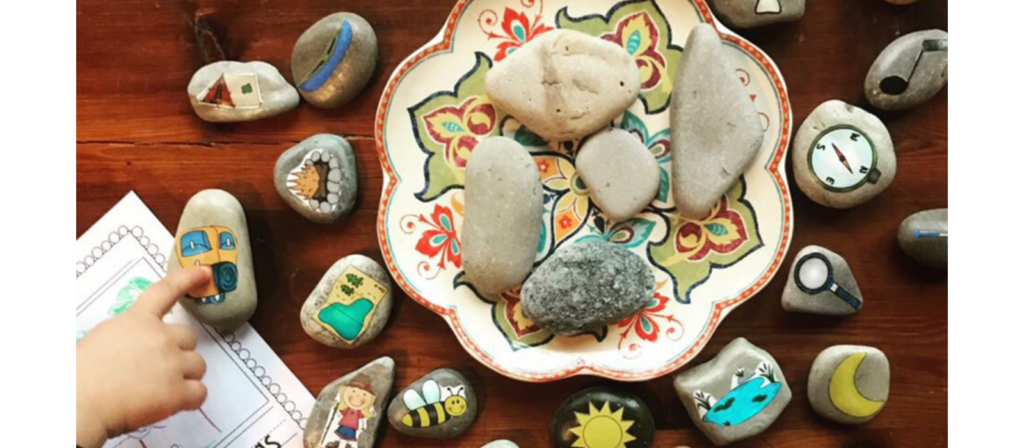
Activity Introduction:
Story stones are a versatile, hands-on storytelling tool that turns language development into an imaginative adventure. By painting or decorating small stones with images of characters, animals, objects, or places, preschoolers can create endless story combinations while strengthening vocabulary, sequencing, and expressive language skills.
How to Do It:
- Collect small, smooth stones and paint simple pictures (a tree, dog, sun, etc.).
- Please place them in a basket or bag.
- Children draw 3–5 stones and use them to invent a story.
- Let them tell their story out loud or act it out with props.
This supports story structure, sequencing, and expressive language skills.
23. Water Writing

Activity Introduction:
Water writing is a refreshing and interactive way for preschoolers to practice letter formation during the warm summer months. Using just a brush and water, children can “paint” letters, numbers, or sight words on sidewalks, fences, or chalkboards, watching them disappear as they dry.
How to Do It:
- Give children a small bucket of water and a paintbrush or sponge.
- Have them “paint” letters, numbers, or words on sidewalks or fences.
- You can guide with letter prompts or let them free-write.
- Watch how the letters evaporate and invite them to rewrite.
It’s a great way to build letter recognition, fine motor control, and spelling skills.
24. Outdoor Storytime Theater

Activity Introduction:
Dramatic storytelling brings books to life. This activity transforms classic read-alouds into performances, making it one of the most imaginative summer activities for preschoolers.
How to Do It:
- Choose a favorite short story or a familiar book.
- Assign characters to children or use puppets and props.
- Rehearse simple lines or actions outdoors.
- Invite other children or families to watch the performance.
This encourages comprehension, character recognition, public speaking, and cooperation.
25. Create a Summer Journal

Activity Introduction:
Journaling is a gentle, personal way to reflect and grow. This low-pressure, open-ended activity makes writing a regular part of your summer activities for preschoolers.
How to Do It:
- Give each child a small blank notebook as their “Summer Journal.”
- Each day, ask them to draw something they did or saw (a trip to the park, eating watermelon, etc.).
- For older preschoolers, encourage labeling with beginning sounds or simple words.
- Let children share entries during circle time.
This supports early writing, memory recall, and confidence in self-expression.
These summer activities for preschoolers keep language and literacy skills fresh and growing, even when the school year takes a break. With a mix of movement, nature, and storytelling, children build a solid foundation for reading success through joy and play.
26. Alphabet Nature Hunt
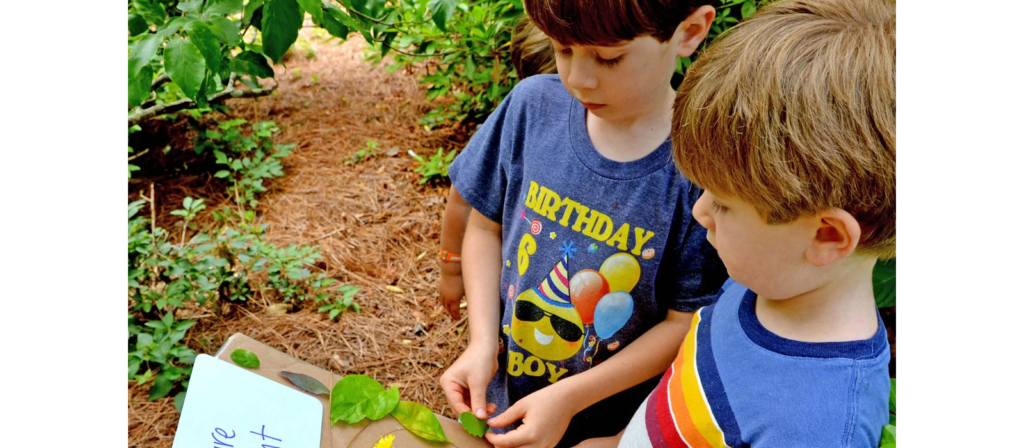
Activity Introduction:
This outdoor scavenger hunt combines literacy with nature, two essential components of the best summer activities for preschoolers. It helps children link letters with real-world objects.
How to Do It:
- Create a list of alphabet letters (A to Z or fewer, depending on age).
- Go on a nature walk and ask children to find objects that begin with each letter—like “B” for bug, “L” for leaf.
- Use clipboards and let them draw or take photos of what they find.
- End the activity with a group share or alphabet book creation.
It boosts letter recognition, phonemic awareness, and vocabulary expansion.
Summer Sensory Activities for Preschoolers
Summer is the perfect time to engage children’s senses through playful, hands-on exploration that supports growth and learning. These summer sensory activities for preschoolers invite little ones to splash in water tables, dig through sand bins, or explore nature-inspired textures, all while building cognitive skills and emotional regulation.
27. Sand Tray Letter Tracing

Activity Introduction:
This activity turns a simple tray of sand into a powerful literacy and motor skill tool. It’s a calm, hands-on way to practice letter recognition and pre-writing—a true classic in summer activities for preschoolers.
How to Do It:
- Fill shallow trays or boxes with clean, dry sand.
- Show children how to “write” letters, numbers, or shapes with their finger or a stick.
- Say the letter sound aloud as they trace it.
- For added fun, use colored sand or bury alphabet cards underneath for them to uncover.
This improves tactile feedback, hand control, and letter formation.
28. Nature Clay Imprints

Activity Introduction:
Combining natural textures and art, this outdoor activity helps preschoolers focus on detail and design. It’s a calming, beautiful addition to your summer activities for preschoolers list.
How to Do It:
- Provide small balls of air-dry clay or salt dough.
- Let children press leaves, twigs, or flowers into the surface to make textured imprints.
- Gently remove the objects to reveal the patterns.
- Optional: let dry and paint the clay disks later.
This develops sensory awareness, fine motor coordination, and observation skills.
29. Sensory Walking Path

Activity Introduction:
Barefoot sensory paths are a fun way to explore textures through touch—an ideal sensory experience for summer. They’re unique, memorable, and an all-body summer activity for preschoolers.
How to Do It:
- Use shallow bins or trays and fill each with different materials: grass, sand, pebbles, water, soft fabric, mud, etc.
- Lay the trays in a sequence to form a path.
- Let children walk barefoot and describe what they feel.
- Encourage conversations about soft, rough, cold, squishy, etc.
This supports sensory integration, language development, and balance.
30. Frozen Treasure Hunt
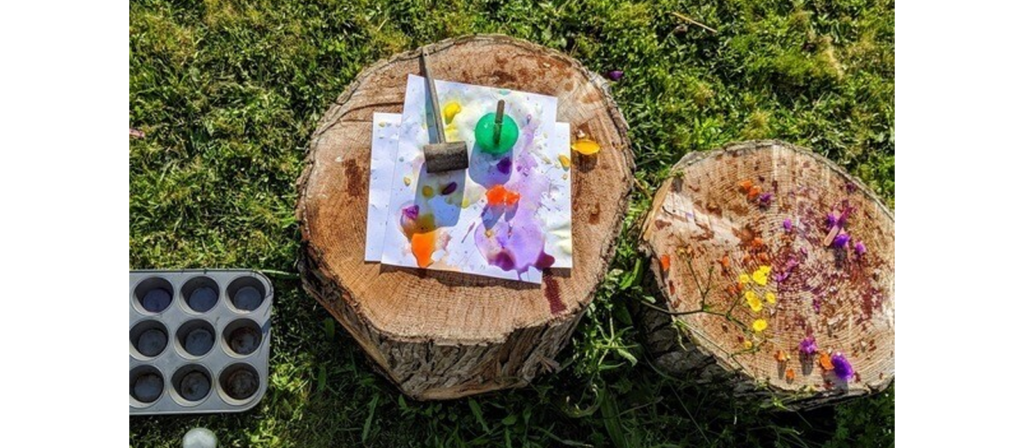
Activity Introduction:
This sensory-rich activity turns ice into an exploration tool. It’s a refreshing and tactile addition to your summer activities for preschoolers, especially on hot days.
How to Do It:
- Freeze small plastic toys, beads, or natural items in a water container.
- Once frozen solid, give children tools (droppers with warm water, spoons, toy hammers) to free the items.
- Prompt counting, describing, and sorting the items they retrieve.
This activity boosts fine motor strength, problem-solving, and scientific inquiry.
These hands-on summer activities for preschoolers help balance active play with focused exploration. Whether making leaf imprints in clay or freeing “frozen treasure,” children constantly develop cognitive, sensory, and motor skills in fun and meaningful ways.
Summer Activities for Dramatic Play and Imagination
Summer offers endless opportunities for preschoolers to step into new roles, create stories, and express themselves through pretend play. These dramatic play summer activities for preschoolers encourage imagination as children transform into explorers, chefs, or astronauts, building language, social skills, and creativity along the way. By providing open-ended props and themed play scenarios, you turn simple summer days into magical adventures filled with storytelling and cooperative play.
31. Ice Cream Shop Role Play

Activity Introduction:
Nothing says summer like ice cream! Setting up a pretend ice cream shop is a favorite among summer activities for preschoolers, helping them practice social interaction, counting, and language through dramatic play.
How to Do It:
- Create a “shop” using a small table, scoops, bowls, and pom-poms as pretend ice cream.
- Add signs with prices and name tags for “workers” and “customers.”
- Use play money for simple math and transactions.
- Rotate roles so everyone gets a turn to “serve” and “buy.”
This fosters role-playing, language use, math awareness, and imaginative storytelling.
32. Camping Pretend Play
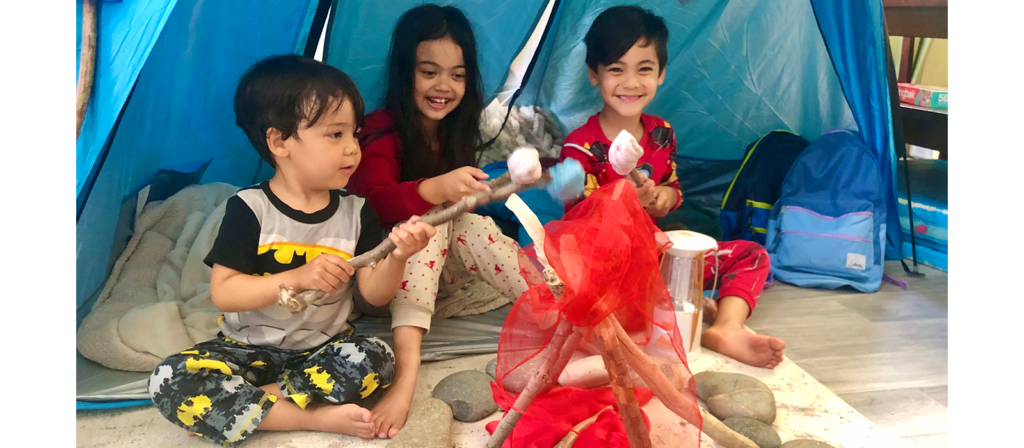
Activity Introduction:
Camping pretend play brings the outdoors to life and is an excellent way to promote storytelling, teamwork, and problem-solving—hallmarks of the best summer activities for preschoolers.
How to Do It:
- Set up a play tent or use blankets and chairs to create one.
- Add flashlights, pretend campfires (paper flames or tissue), sleeping bags, and nature props.
- Kids can pretend to go on hikes, tell stories by the “campfire,” or make “s’mores” from craft materials.
- Encourage them to narrate what happens on their “camping trip.”
It develops sequencing, creative thinking, and social dialogue.
33. Outdoor Kitchen & Restaurant
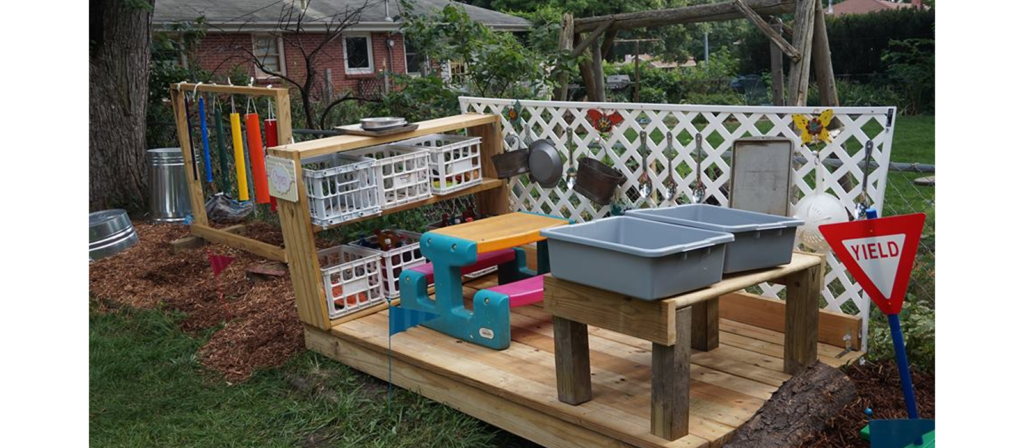
Activity Introduction:
Pretend cooking outdoors using mud, water, flowers, and grass adds a natural twist to dramatic play. This is one of the most immersive summer activities for preschoolers, encouraging both sensory and imaginative development.
How to Do It:
- Set up an area with old kitchen tools: pots, pans, bowls, utensils, and trays.
- Allow children to mix natural materials to create “recipes.”
- Add a menu board with picture options and take orders.
- Have a designated chef, server, and customer.
This supports pretend role-playing, creative expression, and language development.
34. Superhero Training Camp

Activity Introduction:
Transform your playground into a superhero world with this high-energy, pretend play activity. It ranks high among physical and imaginative summer activities for preschoolers.
How to Do It:
- Give children capes (towels or fabric pieces work great), masks, and name tags.
- Set up obstacle courses or “missions” involving jumping, crawling, and saving stuffed animals.
- Have kids invent superhero names and powers.
- Talk about what makes a hero kind, brave, and helpful.
This encourages gross motor activity, storytelling, and empathy.
35. Pirate Adventure Day

Activity Introduction:
Preschoolers love pretending to sail the seas, find buried treasure, and speak like pirates. Pirate day is a full-themed adventure that makes a fantastic addition to any summer activities for preschoolers.
How to Do It:
- Provide pirate hats, cardboard spyglasses, and a treasure map.
- Hide “gold coins” or small toys around the yard or play area.
- Let kids follow the map, solve clues, and collect treasure.
- Create a pirate ship from cardboard boxes or chairs.
This activity builds problem-solving, collaboration, and spatial awareness through imaginative play.
These dramatic summer activities for preschoolers invite kids into new roles and experiences that stretch their imagination and build social-emotional skills. Children learn through every creative moment, whether they’re scooping pretend ice cream, cooking mud pies, or saving the world as superheroes.
Summer Activity Calendar for Preschoolers
If you’re overwhelmed by all the amazing summer activities for preschoolers and wondering which ones to choose first, we’ve made it easy for you. Below is a thoughtfully designed monthly activity calendar with a balanced mix of sensory, STEM, art, movement, and literacy-based activities already covered in this article. These activities are easy to implement and keep your summer plans engaging, educational, and fun.
June Activities for Preschoolers
Kick off summer with colorful, hands-on activities that stimulate curiosity and creativity.
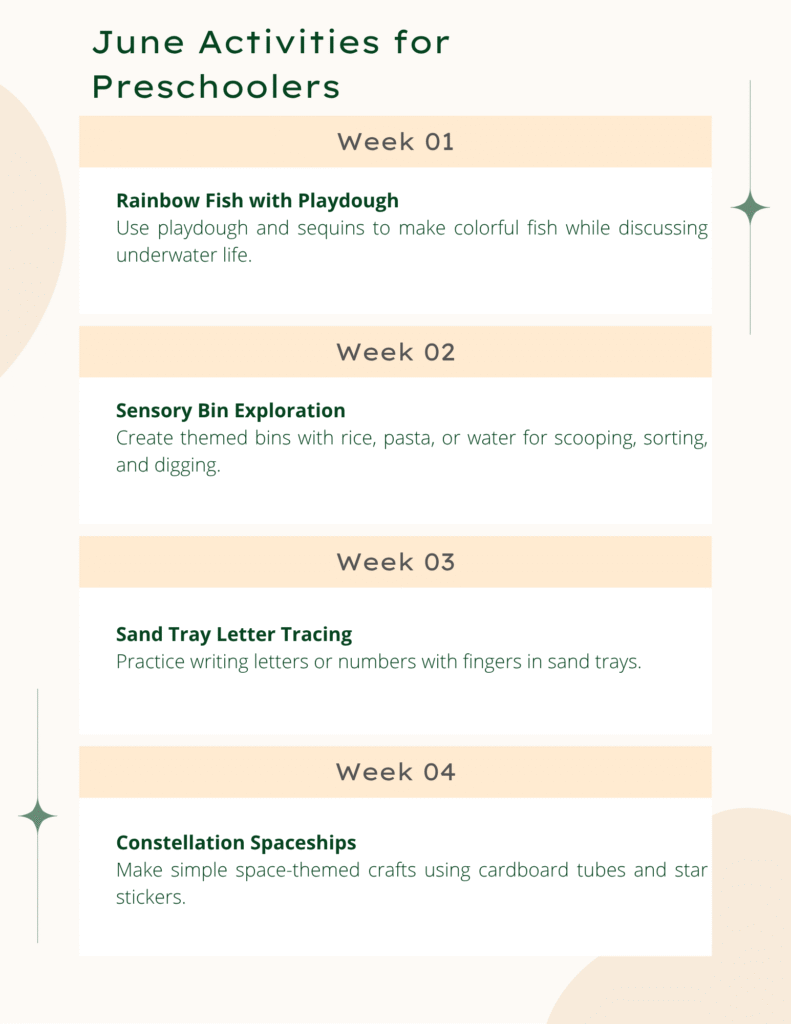
July Activities for Preschoolers
July is a great time to explore patriotic themes, creative expression, and math through movement and nature.

August Activities for Preschoolers
As summer wraps up, August is a great month to wind down with self-expression, science play, and memory-making.

Heat and Water Safety for Children
Outdoor play is a massive part of fun summer activities for preschoolers and is essential for children’s physical and mental health. However, hot summer temperatures can present significant health risks to young children. Heat-related issues such as dehydration, heat cramps, heat exhaustion, and even heat stroke are serious concerns, especially for children aged 3 to 5.
Keep your children safe from heat-related complications with the tips below:
- Encourage children to hydrate throughout the day, even before they feel thirsty
- Take breaks every 20 minutes to cool down (and drink water) during any activity
- Advise families to dress children in light, breathable, sun-protective clothing
- Look out for signs of dehydration such as headaches, lightheadedness, dry lips and tongue, and lack of energy
- Contact the child’s family or pediatrician if you notice signs of severe dehydration like sunken eyes, no tears when crying, dry mouth and tongue, and extreme tiredness
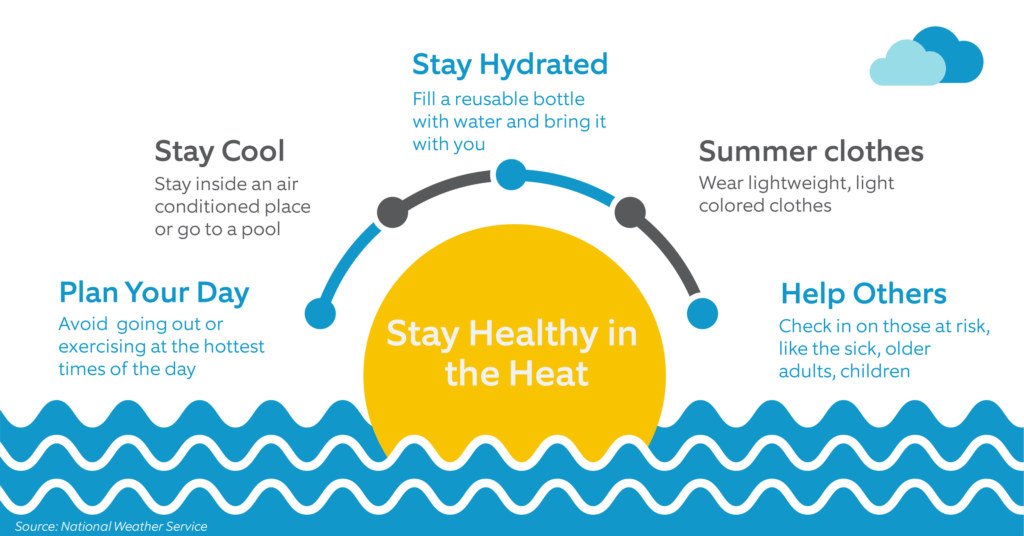
Children aged 3 to 5 need approximately 4 to 5 cups of daily beverages (including water or milk). However, this amount may need to be increased depending on the child’s activity level and outside heat and humidity.
Alongside high temperatures, summer also brings an increase in water-related play. Anything that holds water, such as swimming pools, tubs, buckets, or water tables, poses a high drowning risk for preschoolers. Alarmingly, children can drown in just one to two inches of water, and it often happens silently. That means even seemingly harmless summer activities for preschoolers, like rainbow bubbles or water sensory bins, can be dangerous if not closely supervised.
Keep children safe from drowning with these water safety guidelines:
- Ensure any pool (including inflatable ones) is surrounded by a secure fence on all sides
- Never leave preschoolers unattended near any body of water—they move fast and explore quickly
- Closely and constantly supervise all water-related activities, no matter how shallow
- Learn CPR and basic first aid so you’re prepared in the event of an emergency
- Empty all water-filled containers immediately after use and store them out of reach

Following these heat and water safety tips will allow preschoolers to enjoy outdoor fun while
Tips for Successfully Implementing Summer Activities for Preschoolers
Planning and selecting the right summer activities for preschoolers is only half the equation—executing them smoothly makes all the difference. Whether you’re organizing a program for a preschool, daycare, or early learning center, the tips below will help you keep children engaged, safe, and excited from the first day of summer to the last.
1. Keep Activities Short and Flexible
Preschoolers thrive on routine but need flexibility. Aim for 15–30 minute blocks and be prepared to extend or switch if interest shifts. It’s not about completing an activity perfectly—it’s about the experience of discovery and joy.
2. Always Prep Materials Ahead of Time
Set up activity zones or trays before children arrive. When materials are prepared in advance, transitions become smoother, behavior is easier to manage, and children stay focused on learning through play.
3. Mix Quiet and Active Time
Balance high-energy outdoor activities with calmer indoor moments like journaling or storytelling. This helps regulate energy levels and supports different learning styles within the group.
4. Document the Learning
Capture photos, quotes, or child-made creations and share them with families or use them for classroom displays. This helps show the value of summer activities for preschoolers and promotes positive engagement with caregivers.
5. Adapt the Space to Match the Season
Make minor seasonal adjustments to your preschool environment. Set up a water table near outdoor seating, add shade covers for outdoor crafts, or rotate materials to reflect summer themes. Schools furnished with adaptable, modular pieces—like those offered by experienced B2B furniture manufacturers—can do this easily and professionally.
By planning and staying flexible, you can implement summer learning that’s not only developmentally appropriate but truly magical. Great activities are essential, but your setup, environment, and responsiveness turn them into lasting memories for every child.

FAQ – Summer Activities for Preschoolers
Here are some of the most common questions we receive from parents, educators, and childcare providers about planning and implementing practical summer activities for preschoolers. This quick FAQ will help you clarify goals, prepare better, and keep kids safe and happy all summer.
Q1: What makes a good summer activity for preschoolers?
A good summer activity for preschoolers is play-based, developmentally appropriate, and supports language, motor control, and social interaction skills. The best activities also involve movement, sensory input, and creativity—splashing with water, building with blocks, or painting under the sun.
Q2: How long should summer activities last for preschoolers?
Preschoolers have shorter attention spans, so most summer activities should last 15 to 30 minutes, depending on the child’s interest and energy level. Some children may engage longer when deeply involved in imaginative or sensory play. Always offer flexible transitions and breaks as needed.
Q3: How can I keep summer activities both fun and educational?
Blend learning goals into play. For example:
- Turn a walk into a counting game
- Use nature finds for sorting or patterns
- Let children retell stories during dramatic play
By connecting play to skills, children build knowledge while still having fun. Also, rotate materials and themes regularly to keep things fresh and exciting.
Q4: What are the best materials to use for outdoor summer activities?
Some excellent low-cost and versatile materials include:
- Sidewalk chalk
- Water tables, sponges, and buckets
- Natural objects (sticks, leaves, rocks)
- Loose parts like lids, cups, boxes
- Spray bottles and washable paints
Using these items makes it easy to plan creative and open-ended summer activities for preschoolers that adapt to any environment.
Q5: How do I handle group summer activities with different age levels or abilities?
Differentiate the same activity. For example:
- While one child paints letters with water, another might spell their name or copy a word.
- In a counting game, offer some kids small numbers and others higher-level addition.
Also, use peer support and modeling—older or more experienced children can guide younger ones. Most importantly, always focus on process over product.
Q6: How do I include children with sensory sensitivities?
Offer sensory-friendly options in every activity. For example, provide gloves or tools to reduce direct contact if you’re doing messy play. Allow children to opt out or modify how they engage. Use visual schedules, calming zones, and predictable routines to support comfort.
Q7: How can I involve parents or caregivers in summer learning?
Share weekly plans, photos, and suggestions for at-home extensions like books to read or simple games to try. Invite families to join outdoor events or storytime. Most importantly, communicate the value of play-based summer learning, so they understand it’s more than just fun—it’s preparation for lifelong success.
Q8: Do I need special equipment or materials to do these activities?
Not at all! Most of the best summer activities for preschoolers can be done using everyday, low-cost items like water, chalk, natural materials, paper, or recycled containers. The key is creativity and intentionality, not expensive supplies. Activities using loose parts, nature finds, or DIY tools (like sponge paintbrushes or cardboard forts) often engage children more than store-bought kits. That said, a few reusable basics like buckets, paint, or plastic tools are helpful to keep on hand for repeated use across different activities.
Q9: Can these activities be done indoors or outdoors?
Yes, many summer activities for preschoolers can be easily adapted for either setting. For example:
- A sensory bin that’s messy outside can become a towel-lined table activity inside.
- Storytime theater works equally well on a picnic blanket or in a cozy classroom corner.
- Water play can be scaled down for small containers and managed over a waterproof surface indoors.
That said, summer offers an excellent opportunity to embrace the outdoors when possible. When choosing a location, just consider weather, safety, and child comfort.
Q10: Are these activities appropriate for all preschool age groups?
Yes, most of these summer activities for preschoolers are designed to be flexible and developmentally appropriate across the 3–5 age range. You can easily modify the activity’s complexity to meet each child’s ability. For example:
- Younger children might focus on exploring textures or naming colors.
- Older preschoolers can engage in more structured challenges like counting, storytelling, or team play.
Always observe how individual children respond and offer scaffolding or independent exploration as needed. What matters most is not perfection, but engagement and joy.

Conclusion
Summer is more than just a season—it’s a stage for exploration, creativity, and foundational growth. From outdoor races and math games to sensory experiments and literacy adventures, summer activities for preschoolers offer rich opportunities to nurture curiosity and build essential early skills. This guide was designed to help educators, parents, and childcare providers plan a summer filled with intentional play and joyful discovery, while balancing structure with freedom, and learning with laughter.
As you implement these activities across indoor and outdoor settings, remember that the environment plays a vital role. A well-equipped, flexible, child-centered space can elevate every experience, from messy art on washable tables to storytelling in cozy corners. Brands like West Shore Furniture, known for creating durable, functional, and affordable daycare and preschool furniture, make it easier for early childhood centers to bring these ideas to life. Their thoughtful designs support everything from water play zones to dramatic play corners, ensuring that every preschool environment is as ready for summer as the children.
So, whether you’re tracing letters in sand, blasting off into a cardboard spaceship, or winding down with storytime under a tree, remember: with the right mix of creativity, planning, and environment, summer activities for preschoolers become the building blocks of joyful, purposeful learning.





